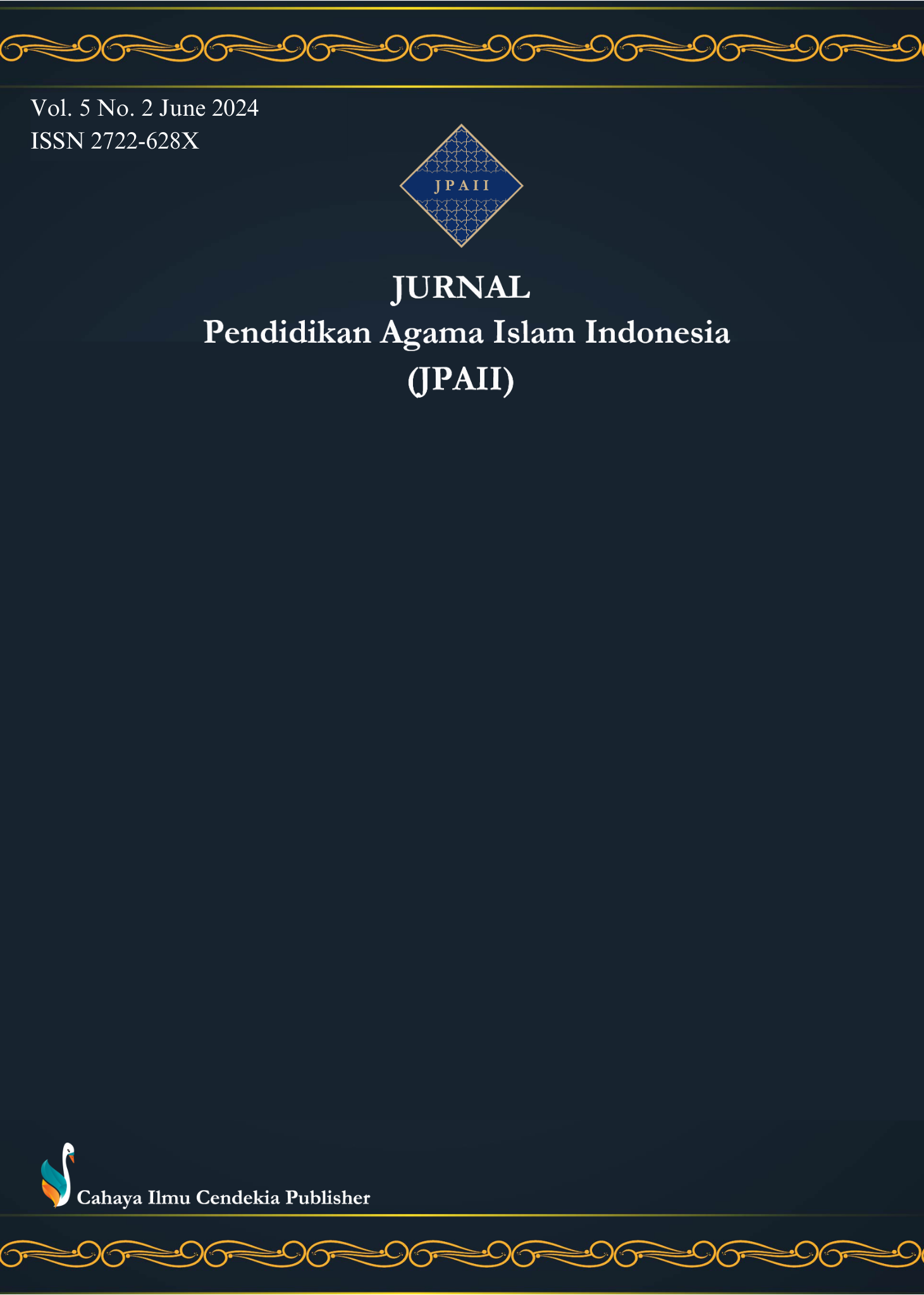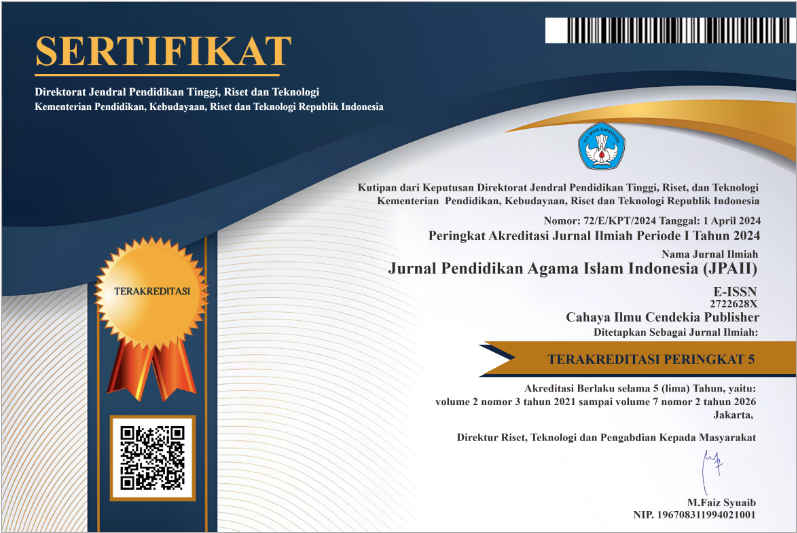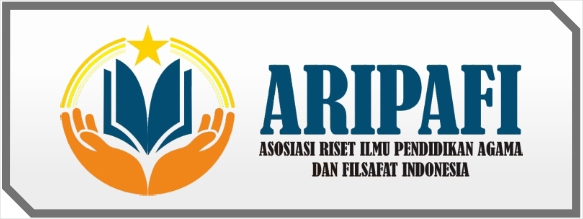Implementation of the Islamic Religious Education Learning Model for Deaf Students: Empirical Study in Salatiga State Special Middle Schools
Abstract
Purpose of the study: This research aims to find out 1). Implementation of learning models, methods and learning media for islamic religious education for deaf students at Salatiga State Special Middle Schools. 2). Difficulties and solutions made by teachers in implementing the learning model.
Methodology: Research uses qualitative methods based on primary and secondary data sources. Data collection was obtained through observation, structured and unstructured interviews, and documentation. Meanwhile, the data analysis technique involves collecting, reducing, presenting, drawing conclusions, and checking the validity of the data which includes triangulation of data sources and triangulation of methods.
Main Findings: The results of the research concluded that in the implementation (application) of the learning model, especially for deaf students, teachers used more sign language and movements, oral approaches, writing methods, training/practical activities, and the use of visual media. And not all learning models can be implemented perfectly in the teaching and learning process, especially for deaf students. Meanwhile, the methods used are lecture method, practice/exercise, drill, reflective maternal method, insist on writing, bang jo method, maching a card, provide captioning. and the learning media used are lcd, whiteboard, puzzle card, video, and traffic teaching aids. The difficulties faced by teachers in the learning process for deaf students are influenced by teacher and student factors. The expectations of Islamic Religious Education teachers in the future are to prioritize memorizing the practice of ablution and prayer (prioritizing the movements).
Novelty/Originality of this study: The novelty of this research is that it examines the implementation of Islamic religious education learning for deaf students . As well as looking for solutions to the obstacles faced by teachers in teaching Islamic religious education to deaf students.
References
F. Sartika, M. Ritonga, and A. Rasyid, “Implementation of Islamic Religious Education in Madrasah Ibtidaiyah During Covid-19 Pandemic,” Khalifa J. Islam. Educ., vol. 4, no. 2, p. 97, 2020, doi: 10.24036/kjie.v4i2.95.
M. Taufik, “Strategic Role of Islamic Religious Education in Strengthening Character Education in the Era of Industrial Revolution 4.0,” J. Ilm. Islam Futur., vol. 20, no. 1, pp. 86–104, 2020, doi: 10.22373/jiif.v20i1.5797.
D. Siddik, S. Syafaruddin, and H. Widodo, “The Implementation of Education and Training Program of Madrasah Islamic Religion Teacher in Improving Profesionalism Teacher (Case Study at Religious Traning Center Medan),” IOSR J. Humanit. Soc. Sci., vol. 22, no. 05, pp. 01–09, 2017, doi: 10.9790/0837-2205080109.
K. Altmeyer, S. Kapp, M. Thees, S. Malone, J. Kuhn, and R. Brünken, “The use of augmented reality to foster conceptual knowledge acquisition in STEM laboratory courses—Theoretical background and empirical results,” British Journal of Educational Technology, vol. 51, no. 3. pp. 611–628, 2020, doi: 10.1111/bjet.12900.
H. M. Hegna and T. Ørbæk, “Traces of embodied teaching and learning: a review of empirical studies in higher education,” Teach. High. Educ., vol. 29, no. 2, pp. 420–441, 2024, doi: 10.1080/13562517.2021.1989582.
K. Rana and K. Rana, “ICT Integration in Teaching and Learning Activities in Higher Education: A Case Study of Nepal’s Teacher Education,” Malaysian Online J. Educ. Technol., vol. 8, no. 1, pp. 36–47, 2020, doi: 10.17220/mojet.2020.01.003.
S. Yumnah, “E-Learning Based Islamic Religious Education of Learning Media: Alternative Solutions for Online Learning During Covid-19,” Nazhruna J. Pendidik. Islam, vol. 4, no. 2, pp. 249–260, 2021, doi: 10.31538/nzh.v4i2.1209.
A. N. Fahmi, M. Yusuf, and M. Muchtarom, “Integration of Technology in Learning Activities: E-Module on Islamic Religious Education Learning for Vocational High School Students,” J. Educ. Technol., vol. 5, no. 2, pp. 282–290, 2021, doi: 10.23887/jet.v5i2.35313.
P. D. Sundari and W. S. Dewi, “Interactive recitation methods as a solution to the students’ deepening physics material during the Covid-19 pandemic,” in Journal of Physics: Conference Series, 2021, vol. 1876, no. 1, pp. 1–7, doi: 10.1088/1742-6596/1876/1/012071.
H. Abuhassna, W. M. Al-Rahmi, N. Yahya, M. A. Z. M. Zakaria, A. B. M. Kosnin, and M. Darwish, “Development of a new model on utilizing online learning platforms to improve students’ academic achievements and satisfaction,” Int. J. Educ. Technol. High. Educ., vol. 17, no. 1, 2020, doi: 10.1186/s41239-020-00216-z.
C. Greenhow and S. Galvin, “Teaching with social media: evidence-based strategies for making remote higher education less remote,” Inf. Learn. Sci., vol. 121, no. 7–8, pp. 513–524, 2020, doi: 10.1108/ILS-04-2020-0138.
W. Naro, A. Abubakar, A. Yani, Kurniati, M. M. Amiruddin, and A. Syatar, “Developing learning method on post-graduated program: A blended learning based on web-blog and print technology design,” Cypriot J. Educ. Sci., vol. 15, no. 5, pp. 1404–1421, 2020, doi: 10.18844/CJES.V15I5.5178.
H. Coşkun, “Media as a Learning-Teaching Tool in the Context of Media Literacy from Turkish Language Teacher Candidates’ Perspective,” Int. J. Educ. Lit. Stud., vol. 9, no. 4, p. 93, 2021, doi: 10.7575/aiac.ijels.v.9n.4p.93.
M. S. Yadav, “Role of Social Media in English Language Learning to the Adult Learners,” Int. J. Linguist. Lit. Transl., vol. 3, no. 11, pp. 55–67, 2020, doi: 10.32996/ijllt.
I. Irviana, “Understanding the Learning Models Design for Indonesian Teacher,” Int. J. Asian Educ., vol. 1, no. 2, pp. 95–106, 2020, doi: 10.46966/ijae.v1i2.40.
S. L. Chew and W. J. Cerbin, “The cognitive challenges of effective teaching,” J. Econ. Educ., vol. 52, no. 1, pp. 17–40, 2021, doi: 10.1080/00220485.2020.1845266.
Y. A. Alnasser, “The perspectives of Colorado general and special education teachers on the barriers to co-teaching in the inclusive elementary school classroom,” Educ. 3-13, vol. 49, no. 6, pp. 716–729, 2021, doi: 10.1080/03004279.2020.1776363.
A. Aruna, N. F. P. Ishlah, L. Inayah, and A. R. Prasetyo, “Educational Game Design ‘Napak Tilas Panji Asmorobangun’ in ‘Wayang Beber’ Story,” EDUTEC J. Educ. Technol., vol. 5, no. 1, pp. 1–25, 2021, doi: 10.29062/edu.v5i1.268.
S. Tambak, “The Method Of Counteracting Radicalism In Schools: Tracing the Role of Islamic Religious Education Teachers in Learning,” MIQOT J. Ilmu-ilmu Keislam., vol. 45, no. 1, p. 104, 2021, doi: 10.30821/miqot.v45i1.761.
M. Vasileva, R. K. Graf, T. Reinelt, U. Petermann, and F. Petermann, “Research review: A meta-analysis of the international prevalence and comorbidity of mental disorders in children between 1 and 7 years,” J. Child Psychol. Psychiatry Allied Discip., vol. 62, no. 4, pp. 372–381, 2021, doi: 10.1111/jcpp.13261.
D. Kinnear et al., “The relative influence of intellectual disabilities and autism on sensory impairments and physical disability: A whole-country cohort of 5.3 million children and adults,” J. Appl. Res. Intellect. Disabil., vol. 33, no. 5, pp. 1059–1068, 2020, doi: 10.1111/jar.12728.
S. M. Roldán, J. Marauri, A. Aubert, and R. Flecha, “How Inclusive Interactive Learning Environments Benefit Students Without Special Needs,” Front. Psychol., vol. 12, no. April, pp. 1–12, 2021, doi: 10.3389/fpsyg.2021.661427.
O. Crispel and R. Kasperski, “The impact of teacher training in special education on the implementation of inclusion in mainstream classrooms,” Int. J. Incl. Educ., vol. 25, no. 9, pp. 1079–1090, 2021, doi: 10.1080/13603116.2019.1600590.
A. K. Nuzuli, “Factors that Influence the Effectiveness of Communication between Teachers and Deaf Students,” J. Komun. Pendidik., vol. 8, no. 1, pp. 25–39, 2024.
E. Tavanai, N. Rouhbakhsh, and Z. Roghani, “A review of the challenges facing people with hearing loss during the COVID-19 outbreak: Toward the understanding the helpful solutions,” Audit. Vestib. Res., vol. 30, no. 2, pp. 62–73, 2021, doi: 10.18502/avr.v30i2.6091.
J. F. Kelly, E. L. McKinney, and O. Swift, “Strengthening teacher education to support deaf learners,” Int. J. Incl. Educ., vol. 26, no. 13, pp. 1289–1307, 2022, doi: 10.1080/13603116.2020.1806366.
D. Turnbull, R. Chugh, and J. Luck, “Learning management systems: a review of the research methodology literature in Australia and China,” Int. J. Res. Method Educ., vol. 44, no. 2, pp. 164–178, 2021, doi: 10.1080/1743727X.2020.1737002.
D. E. DeMatthews, A. Serafini, and T. N. Watson, “Leading Inclusive Schools: Principal Perceptions, Practices, and Challenges to Meaningful Change,” Educ. Adm. Q., vol. 57, no. 1, pp. 3–48, 2021, doi: 10.1177/0013161X20913897.
E. Cagulada and D. Koller, “‘It’s a hearing world’: Parents’ perspectives of the well-being of children who are deaf and hard of hearing,” Deaf. Educ. Int., vol. 22, no. 2, pp. 139–155, 2020, doi: 10.1080/14643154.2019.1635297.
R. Rosalinda, A. Hakam, and I. Mardhiah, “Islamic Religious Education Learning Model for Deaf Children in Special Schools (SLB),” TARBAWY Indones. J. Islam. Educ., vol. 9, no. 2, pp. 154–167, 2022, doi: 10.17509/t.v9i2.25811.
H. Nassaji, “Good qualitative research,” Language Teaching Research, vol. 24, no. 4. pp. 427–431, 2020, doi: 10.1177/1362168820941288.
F. Bogna, A. Raineri, and G. Dell, “Critical realism and constructivism: merging research paradigms for a deeper qualitative study,” Qual. Res. Organ. Manag. An Int. J., vol. 15, no. 4, pp. 461–484, 2020, doi: 10.1108/QROM-06-2019-1778.
E. Knott, A. H. Rao, K. Summers, and C. Teeger, “Interviews in the social sciences,” Nat. Rev. Methods Prim., vol. 2, no. 1, pp. 1–15, 2022, doi: 10.1038/s43586-022-00150-6.
B. L. Handoko, A. N. Mulyawan, J. Tanuwijaya, and F. Tanciady, “Big Data in Auditing for the Future of Data Driven Fraud Detection,” Int. J. Innov. Technol. Explor. Eng., vol. 9, no. 3, pp. 2902–2907, 2020, doi: 10.35940/ijitee.b7568.019320.
Copyright (c) 2024 Fischa Amila, Javad Ostadmohamadi

This work is licensed under a Creative Commons Attribution 4.0 International License.
Authors who publish with this journal agree to the following terms:
- Authors retain copyright and acknowledge that the Jurnal Pendidikan Agama Islam Indonesia (JPAII) is the first publisher licensed under a Creative Commons Attribution 4.0 International License.
- Authors are able to enter into separate, additional contractual arrangements for the non-exclusive distribution of the journal's published version of the work (e.g., post it to an institutional repository or publish it in a book), with an acknowledgment of its initial publication in this journal.
- Authors are permitted and encouraged to post their work online (e.g., in institutional repositories or on their website) prior to and during the submission process, as it can lead to productive exchanges and earlier and greater citation of published work.







.png)
.png)





















